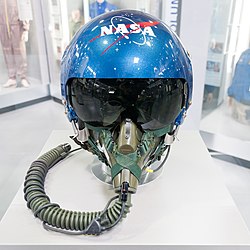

A flight helmet, sometimes referred to as a "skull dome", "bone dome" or "foam dome", is a special type of helmet primarily worn by military aircrew.
Contents
A flight helmet can provide: [1]
- Impact protection to reduce the risk of head injury (e.g. in the event of a parachute landing) and protection from wind blast (e.g. in the event of ejection).
- A visor to shield the eyes from sunlight, flash, supersonic wind blasts and laser beams.
- Noise attenuation, headphones and a microphone (except when included in a mask).
- A helmet mounted display, mounting for night vision goggles and/or a helmet tracking system (so the aircraft knows where the pilot is looking).
The design of a flight helmet may also consider: [1]
- Comfort – including the weight, centre of gravity and provision for cooling and ventilation.
- Compatibility with an oxygen mask (for high-altitude flight and NBC protection).








